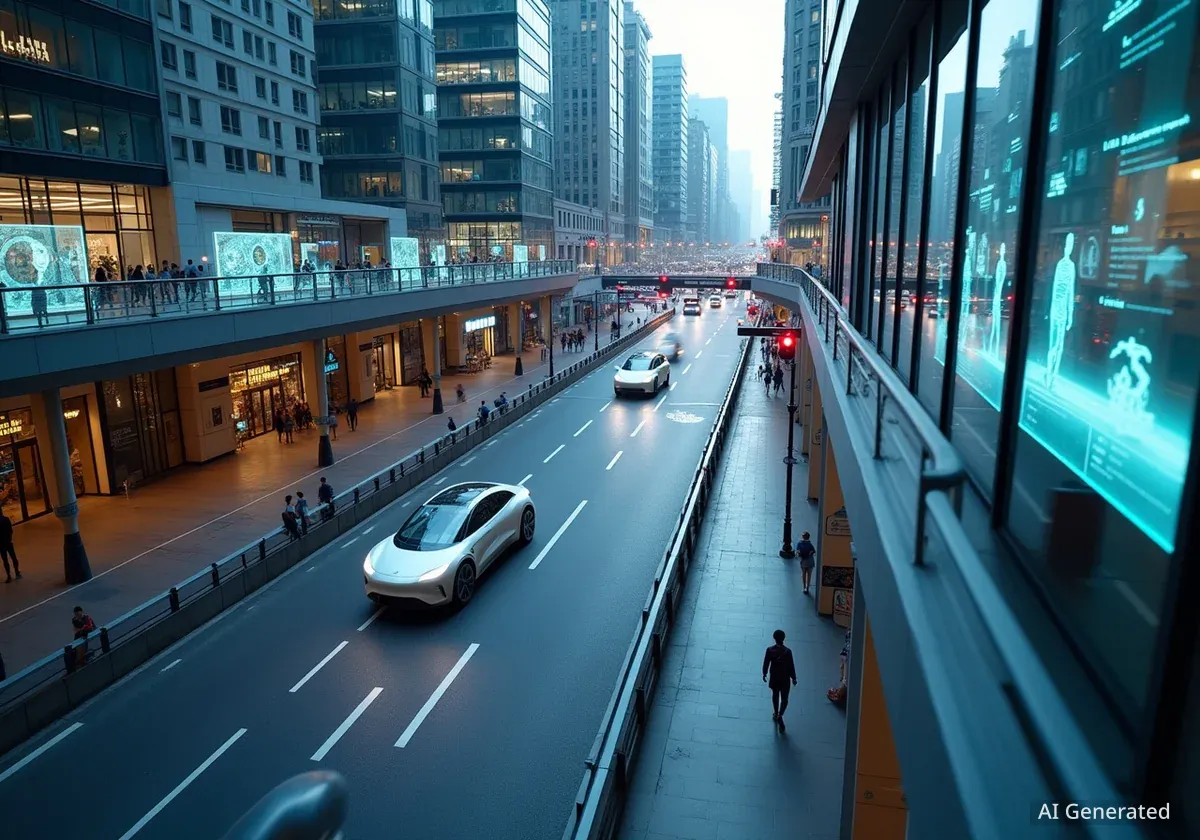A new report from the World Intellectual Property Organization (WIPO) has identified the leading global centers for technological advancement and investment. The 2025 Global Innovation Index (GII) ranks metropolitan clusters based on patent filings, venture capital activity, and scientific research output. These hubs are not just producing new technologies; they are integrating them into the fabric of everyday life, offering a glimpse into a future of seamless, tech-driven living.
The top five clusters—Shenzhen-Hong Kong-Guangzhou, Tokyo-Yokohama, San Jose-San Francisco, Beijing, and Seoul—collectively account for a significant portion of the world's innovation. Residents in these areas experience a unique blend of futuristic convenience and cultural tradition, from cashless street markets to autonomous vehicles operating on city streets.
Key Takeaways
- The Shenzhen-Hong Kong-Guangzhou cluster in China has been named the world's top innovation hub for 2025.
- Collectively, the top 100 clusters are responsible for over 70% of global patents and venture capital deals.
- Tokyo-Yokohama leads the world in international patent filings, accounting for more than 10% of the global total.
- Silicon Valley (San Jose-San Francisco) remains the global leader in venture capital, generating nearly 7% of all deals.
- Asian cities dominate the top rankings, highlighting a significant shift in global innovation power.
1. Shenzhen-Hong Kong-Guangzhou: Where Tradition Meets Tech
The Pearl River Delta region, encompassing Shenzhen, Hong Kong, and Guangzhou, has secured the top spot in the GII rankings. This area has become a powerhouse, driven by a surge in patents, scientific investment, and venture capital. China now hosts 24 of the 100 leading clusters identified in the report.
In this region, advanced technology is not confined to corporate labs; it's a part of daily commerce and life. Residents describe a unique environment where old and new coexist. At street markets, vendors accept mobile QR code payments alongside traditional cash transactions. Small business owners often manage logistics and deliveries using multiple smartphone applications simultaneously.
Hong Kong's Octopus card, introduced in 1997 for public transit, exemplifies this practical approach to innovation. It has evolved into an all-purpose payment system used for everything from vending machines to parking meters.
From Fishing Village to Tech Metropolis
Shenzhen's rise was a deliberate strategic initiative. In 1980, the Chinese government designated it as the country's first Special Economic Zone. This status provided tax incentives and other benefits to attract investment and foster innovation. Today, it is home to global tech giants like Huawei and Tencent and is recognized as a UNESCO Creative City.
The city's government actively supports a culture of creation. Makerspaces like the Shenzhen Open Innovation Lab provide public access to advanced tools, including virtual reality setups and 3D printers, fostering a community of hobbyists, students, and professionals.
Leon Huang, a resident since 2008, noted the city's supportive framework. "This supportive framework enables rapid scaling and experimentation," he said. He pointed to the elaborate drone shows over Shenzhen Talent Park Bay as a public display of the city's technological prowess, with one recent event setting a world record by using nearly 12,000 drones.
2. Tokyo-Yokohama: Practical and Human-Centered Innovation
Ranked second, the Tokyo-Yokohama cluster is a global leader in intellectual property, producing the highest number of international patent filings worldwide. Despite its high-tech reputation, residents emphasize that technology here is designed to be practical and helpful rather than overtly flashy.
Dana Yao, who divides her time between Japan and the United States, described the innovation as subtle but powerful. "In Japan, tech isn't some wild imagination of flying cars," she explained. Instead, it's the small, impactful solutions, like a single transit card that also works for buses and vending machines, or AI-powered sensors at convenience stores that enable seamless self-checkout.
This focus on human-centric technology is evident across the city. Visitors can experience it firsthand by riding the fully automated, driverless train on the Yurikamome Line, which offers panoramic views of Tokyo Bay and the Rainbow Bridge.
Did You Know?
The Tokyo-Yokohama cluster is responsible for over 10% of all international patent applications filed globally, making it the most prolific region for new inventions and intellectual property creation.
For those seeking a more immersive experience, art installations like teamLab Planets merge technology with creativity. "Entire rooms react to your movements, light and sound," Yao said, highlighting how technology can create powerful, interactive experiences.
3. San Jose-San Francisco: The Epicenter of Venture Capital
Widely known as Silicon Valley, the San Jose-San Francisco cluster continues to dominate the world of venture capital. According to the GII report, this area generates nearly 7% of all global VC deals and has the most concentrated innovation activity per person.
This high density of talent and capital creates a unique environment for entrepreneurship. Ritesh Patel, founder of Ticket Fairy and a new resident, described the atmosphere as reminiscent of the original dot-com boom. "Very smart people are congregating here and people who left have come back," he said.
"You could be at a dinner having a conversation about challenges you're facing as a startup founder and the next minute someone at the table says that they can help. They send a text and suddenly you have an intro... It's wild!"
This ecosystem allows for rapid networking and problem-solving that is difficult to replicate elsewhere. For visitors and residents alike, the region offers a chance to experience technology before it becomes mainstream. Services like Uber and Lyft were widely used here long before their global expansion. Today, autonomous Waymo cars are a common sight, available to anyone with the company's app.
4. Beijing: Blending High-Tech with Deep-Rooted Culture
China's capital city, Beijing, stands out for its immense scientific research output, contributing 4% of all globally published academic papers. Residents describe a city that successfully balances cutting-edge infrastructure with its rich cultural heritage.
Elle Farrell-Kingsley, an AI futurist based in the city, noted this unique blend. "Other 'smart cities' really focus on modern edge, but Beijing blends innovation, culture and livability," she said. Daily life is streamlined through "super apps" like Alipay and WeChat, which integrate payments, translation, food ordering, and other services into a single platform.
AI is deeply integrated into these services, making tasks like real-time translation accessible and reliable. Farrell-Kingsley mentioned that the efficiency of these systems is so complete that it can be jarring to travel elsewhere. "I rarely see major tech mishaps, and often find myself frustrated or impatient when visiting other countries and not having these services," she remarked.
One of the most futuristic experiences available to the public is Baidu's Apollo robotaxi service. These fully autonomous vehicles navigate the city without a steering wheel, offering a tangible look at the future of transportation.
5. Seoul: Innovation Driven by Necessity
Rounding out the top five, Seoul is a major force in global innovation, accounting for 5.4% of global patent applications and ranking second only to San Francisco for venture capital deals in Asia. According to residents, South Korea's intense drive to innovate stems from its history and limited natural resources.
Chris Oberman, who has lived in Seoul since 2024, explained the cultural mindset. "The country has to compete through innovations and technology," he said. "Many people's grandparents lived in poverty, so there is still this huge urge and energy to grow, improve, innovate and not fall behind."
This drive translates into a hyper-convenient daily life. Digital door locks are standard in homes, and the city's cashless payment systems are so ubiquitous that many residents leave their wallets at home, relying solely on their phones for all transactions.
Visitors can see this smart infrastructure in action along the Cheongyecheon Stream, a revitalized public space featuring self-driving electric buses. The city is also dotted with cashierless convenience stores that use AI to track inventory and manage payments, allowing them to operate 24/7 without staff.

